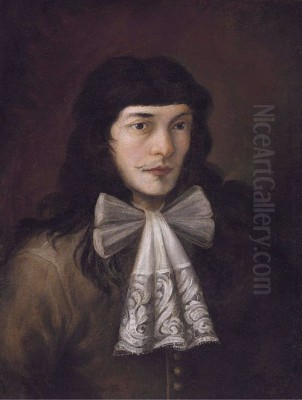
Alessandro Magnasco, often nicknamed Lissandrino, stands as one of the most distinctive and intriguing figures in Italian Late Baroque and Rococo painting. Born in Genoa on February 4, 1667, and passing away in the same city on March 12, 1749, his life spanned a period of significant artistic transition. He carved a unique niche for himself with a highly personal style characterized by rapid, flickering brushwork, dramatic lighting, and often unsettling or unconventional subject matter. While rooted in the Genoese tradition, his work transcends regional boundaries, offering a vision that was both a product of its time and strangely prescient of later artistic developments.
Early Life and Artistic Formation in Milan
Magnasco's journey into the world of art began under the shadow of an early loss. His father, Stefano Magnasco, was a painter of some repute, but he died when Alessandro was very young. This circumstance led the young Magnasco away from his native Genoa to Milan, a major artistic center in Lombardy. Around 1680, he entered the bustling studio of Filippo Abbiati (1640–1715), a prominent Milanese painter known for his large-scale, dramatic religious and historical canvases.
Under Abbiati's tutelage, Magnasco absorbed the Lombard tradition's emphasis on realism, dramatic intensity, and strong chiaroscuro – the interplay of light and shadow. Milanese art, influenced by earlier masters like Daniele Crespi and later figures like Francesco Cairo, often possessed a certain sobriety and emotional depth that likely resonated with the young artist. While Magnasco initially focused on portraiture, reportedly achieving some success, his true artistic inclinations soon pulled him in a different direction.
His early development was also shaped by Genoese masters whose work he would have known. The dynamic compositions and fluid brushwork of Valerio Castello (1624–1659) and the picturesque, often rustic scenes populated with animals and figures by Giovanni Benedetto Castiglione (Il Grechetto, c. 1609–1664) left an imprint on his evolving style. These Genoese predecessors shared a certain painterly freedom and energy that Magnasco would push to new extremes.
The Emergence of a Unique Vision: Style and Technique
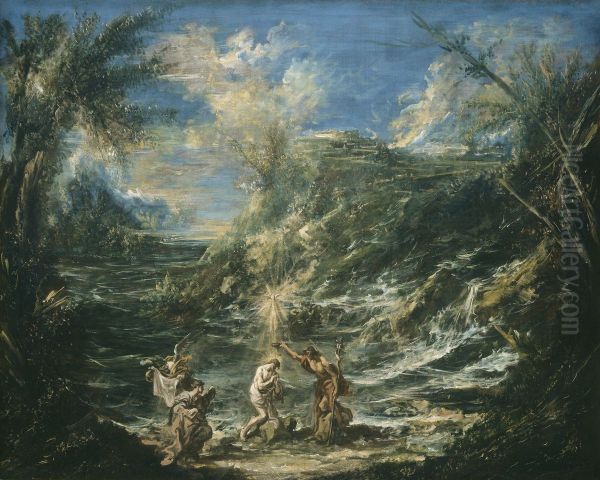
Magnasco's mature style is instantly recognizable and deviates significantly from the polished academicism or decorative grandeur often associated with the late Baroque. His technique is characterized by what Italians call "pittura di tocco" – painting with touches or dabs of the brush. His brushstrokes are quick, nervous, and seemingly spontaneous, building forms through fragmented patches of color and light rather than smooth modeling. This creates a flickering, vibrant surface that imbues his scenes with a sense of restless energy and immediacy.
Light plays a crucial, often theatrical role in his compositions. He employed dramatic chiaroscuro, but his light is rarely soft or diffused. Instead, it often appears as sharp, almost electric flashes illuminating figures and architectural elements against deep, murky shadows. This creates an atmosphere of tension, mystery, and sometimes, outright eeriness. His figures are typically elongated, slender, and almost ghostly, rendered with the same rapid brushwork as their surroundings. They often seem consumed by the vast, decaying spaces they inhabit or agitated by an unseen force.
His color palette tends towards the somber and low-key, dominated by browns, grays, ochres, and muted blues and greens, punctuated by occasional flashes of white or brighter hues for emphasis. This restricted palette enhances the melancholic or dramatic mood of his works. He frequently worked on a relatively small scale, allowing for an intimate yet intense viewing experience.
Unconventional Subjects: Monks, Bandits, and the Margins of Society
Perhaps as striking as Magnasco's style is his choice of subject matter. While he did paint religious scenes, they often possess a raw, mystical fervor far removed from conventional piety. He seemed particularly drawn to the lives of monks, hermits, and penitents, depicting them in prayer, contemplation, or acts of self-mortification within stark, isolated settings. These works convey a sense of intense, almost ecstatic spirituality, but also hint at the psychological burdens of ascetic life.
Magnasco ventured into territories rarely explored by his contemporaries. He painted scenes of Quaker meetings, synagogue services, and Greek Orthodox rituals, displaying an unusual interest in different religious practices, often emphasizing the atmospheric and communal aspects of worship. These works, like The Synagogue (c. 1725-30), are valuable historical documents as well as compelling artistic statements, rendered with his characteristic dramatic lighting and energetic brushwork.
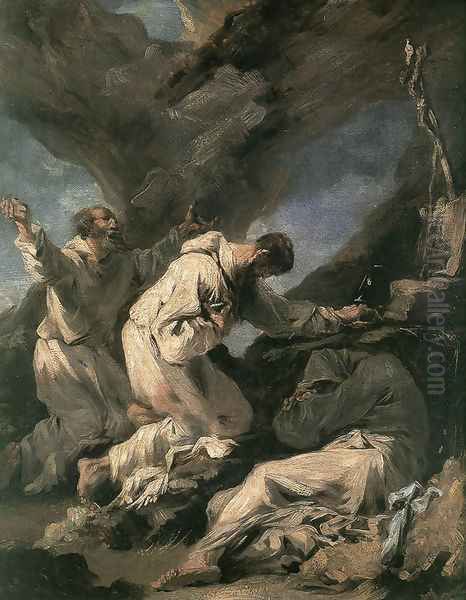
He was also fascinated by the fringes of society. Bandits, gypsies, soldiers, beggars, and prisoners populate his canvases. Scenes like Bandits Resting or Interrogations in Jail depict a world far removed from aristocratic salons or idealized landscapes. These are not romanticized portrayals; they often convey a sense of hardship, desperation, and the precariousness of life, sometimes with a touch of the grotesque or macabre. He depicted shipwrecks, fires, and other disasters, capturing the chaos and human drama inherent in such events.
The Florentine Interlude: Medici Patronage
Between approximately 1703 and 1709, Magnasco spent a significant period in Florence, working under the patronage of Grand Prince Ferdinando de' Medici. This was a period of considerable prestige for the artist. Florence, though perhaps past its Renaissance peak, remained a vital cultural center. Working for the Medici heir placed Magnasco in esteemed company and provided him with important commissions.
His Florentine patrons seemed receptive to his unique style and subject matter. Works from this period often include genre scenes set in elaborate gardens or interiors, sometimes featuring aristocratic figures alongside the more common folk who populated his canvases. The experience likely broadened his horizons and solidified his reputation beyond Milan. The positive reception he enjoyed in Florence, however, stood in contrast to the criticism he would later face in his native Genoa.
During his time in Florence, he may have also absorbed influences from the rich artistic heritage of the city, perhaps finding resonance in the expressive intensity of earlier Florentine masters or the burgeoning interest in genre painting. His interactions with the Medici court provided a unique platform, allowing his unconventional art to be appreciated within one of Italy's most sophisticated cultural environments.
Collaboration and Artistic Exchange
Collaboration was a common practice in the Baroque era, and Magnasco frequently worked with other specialists, particularly landscape and architectural painters. His rapid, figure-focused style complemented the work of artists who specialized in creating detailed settings. He is known to have collaborated extensively with landscape painters such as Antonio Francesco Peruzzini (c. 1643/46–1724) and later Marco Ricci (1676–1730).
He also worked with Clemente Spera (active late 17th–early 18th century), a specialist in painting architectural ruins (rovine). In these collaborations, Magnasco would typically add his distinctive, small, agitated figures into the landscapes or architectural settings provided by his partners. These joint efforts resulted in works where the vastness or decay of nature and architecture forms a dramatic backdrop for the human dramas, often small and seemingly insignificant, unfolding within them.
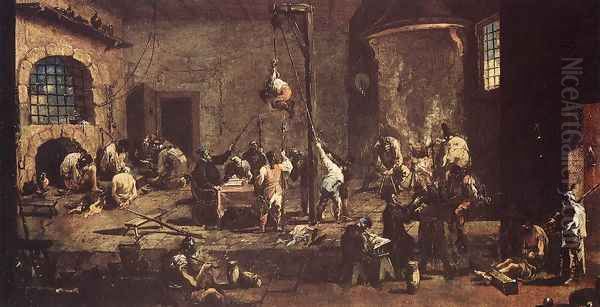
These collaborations highlight Magnasco's focus on the human element, even when figures appear small against their surroundings. His ability to integrate his dynamic figures seamlessly into diverse settings created by others speaks to his versatility and the unique power of his style. These partnerships were mutually beneficial, combining different artistic strengths to create rich, complex compositions that neither artist might have achieved alone.
Later Career: Milan and the Return to Genoa
After his Florentine period, Magnasco returned to Milan, where he continued to be a significant figure. He remained active, producing numerous works that further developed his signature style. His paintings from this period often feature the crowded interiors, stormy landscapes, and dramatic religious or genre scenes that define his oeuvre. Milan remained his primary base for many years, a city whose artistic environment seemed relatively conducive to his work.
However, in 1735, Magnasco made the decision to return permanently to his native Genoa. By this time, Genoese artistic tastes, perhaps more conservative or oriented towards the decorative elegance of the burgeoning Rococo, were less receptive to his rugged, expressive, and often dark style. Sources suggest his work was criticized, deemed too unconventional or lacking in the polished finish favored by some local patrons and artists.
Despite this cooler reception in his final years, Magnasco continued to paint until his death in Genoa in 1749 at the advanced age of 82. His later works show no significant decline in energy, maintaining the flickering brushwork and dramatic intensity that characterized his career. His persistence in his unique vision, even when faced with criticism, underscores his artistic integrity and singular path.
Masterpieces and Representative Works
Several works stand out as exemplary of Magnasco's style and thematic concerns:
The Synagogue (c. 1725-30): Housed in the Cleveland Museum of Art, this painting depicts the interior of a synagogue during worship. It is a remarkable example of his ability to capture the atmosphere of a specific cultural milieu. The flickering light illuminates the praying figures, rendered with rapid strokes, creating a scene that is both documentary and intensely spiritual. The architectural space feels vast and somewhat mysterious.
Meeting of Quakers (c. 1712): This work, found in various versions, portrays a Quaker gathering, another unusual subject for an Italian Catholic painter. Like The Synagogue, it demonstrates his interest in diverse religious expressions. The figures are depicted with earnestness within a typically atmospheric, dimly lit interior, emphasizing the quiet intensity of the gathering.
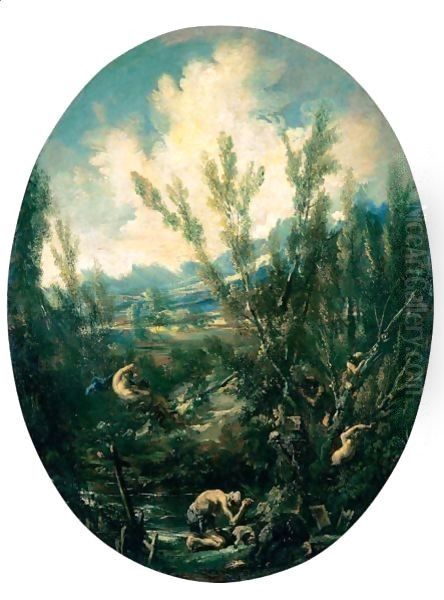
The Baptism of Christ (c. 1740): Located in the National Gallery of Art, Washington D.C., this later work shows Magnasco applying his style to a traditional religious theme. The scene is imbued with a wild, mystical energy. Christ and John the Baptist are surrounded by agitated angels and onlookers, set against a stormy, dramatic landscape. The rapid brushwork and dramatic lighting transform the familiar scene into a visionary event.
Praying Monks (Various versions): Magnasco returned frequently to the theme of monastic life. These paintings often depict monks in dimly lit interiors or rugged landscapes, engaged in fervent prayer or contemplation. The figures are typically elongated and spectral, their forms almost dissolving into the surrounding gloom, conveying intense spiritual devotion mixed with an air of melancholy. Examples can be found in the Rijksmuseum, Amsterdam, and elsewhere.
Bandits Resting or Robbers' Feast (Various versions): These genre scenes capture the rough lives of brigands. Often set in caves or desolate landscapes, they show groups of figures gathered around fires, dividing loot, or carousing. Magnasco imbues these scenes with a sense of raw energy and latent danger, using his characteristic flickering light and shadow to heighten the drama.
Interrogation in Jail (c. 1710): This work exemplifies Magnasco's darker, more socially conscious side. It depicts a harrowing scene of prisoners being interrogated, likely by figures of the Inquisition. The cramped, oppressive space, the dramatic lighting focusing on the suffering figures, and the agitated brushwork create a powerful and disturbing image of human cruelty and despair.
Influences Shaping the Vision
Magnasco's unique style was a synthesis of various influences. His initial training with Filippo Abbiati provided a foundation in Lombard dramaticism. The Genoese tradition, particularly the painterly freedom of Valerio Castello and the picturesque genre scenes of Giovanni Benedetto Castiglione, offered models for dynamic composition and subject matter.
Beyond painting, Magnasco seems to have been significantly influenced by the graphic arts. The etchings of Jacques Callot (1592–1635) and Stefano Della Bella (1610–1664), with their small, lively figures, often depicting soldiers, beggars, festivals, and the miseries of war, resonate strongly with Magnasco's own populated scenes and interest in the everyday and the marginal. The linear energy and sometimes grotesque characterizations in their prints find echoes in Magnasco's painted figures.
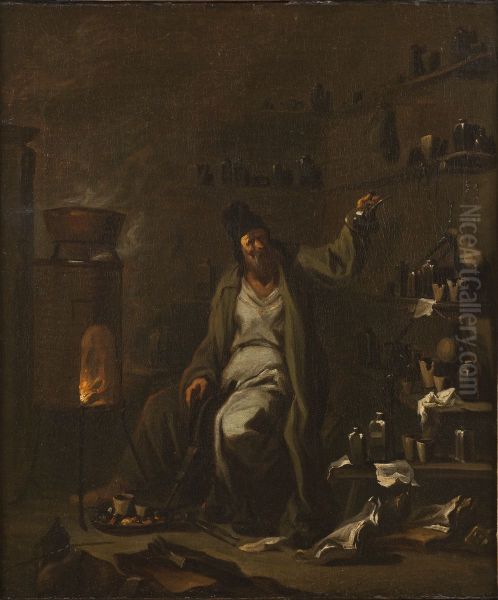
Furthermore, the wild, untamed landscapes popularised by Salvator Rosa (1615–1673), though Rosa worked earlier and primarily in Naples and Rome, likely contributed to the dramatic natural settings Magnasco often employed. The interest in ruins and the picturesque decay seen in his collaborations with Spera also connects to a broader European fascination with antiquity and the passage of time. Some scholars also suggest literary influences, such as Spanish picaresque novels, which chronicled the adventures of rogues and wanderers, mirroring Magnasco's interest in depicting life on the margins.
Legacy, Rediscovery, and Art Historical Standing
After his death, Alessandro Magnasco's work fell into relative obscurity for nearly 150 years. His style was too idiosyncratic, too far removed from the Neoclassical tastes that dominated the later 18th and 19th centuries. It was only in the early 20th century, with the rise of modern art movements like Expressionism that valued subjective feeling and bold technique over academic polish, that Magnasco was rediscovered and his genius reappraised.
Art historians and collectors began to recognize the striking originality of his work. His nervous brushwork, distorted figures, and emotionally charged atmospheres seemed to anticipate aspects of later art. He is sometimes seen as a precursor to the Venetian Rococo painters like Francesco Guardi (1712–1793), whose atmospheric cityscapes and lively figures share some affinity with Magnasco's style (and Guardi may have been influenced by Marco Ricci, Magnasco's collaborator).
Comparisons have also been drawn, perhaps more tenuously, to the darker visions of Francisco Goya (1746–1828) or the social commentary and caricatural style of Honoré Daumier (1808–1879). While direct influence is difficult to prove, Magnasco's willingness to tackle unconventional themes and employ a highly personal, expressive style places him outside the mainstream of his time and connects him spiritually to later artists who prioritized individual vision and emotional impact.
Today, Magnasco is recognized as a major figure of the Italian Late Baroque and Rococo periods. He is celebrated for his technical brilliance, his unique handling of light and brushwork, and his hauntingly atmospheric depictions of a wide range of subjects. His work defies easy categorization, standing apart from the decorative impulses of much Rococo art (as seen in the work of French masters like François Boucher or Jean-Honoré Fragonard) and the formal constraints of classicism.
Conclusion: An Enduring Enigma
Alessandro Magnasco remains a fascinating and somewhat enigmatic figure in the history of art. His paintings transport the viewer into a world that is at once recognizable and strangely dreamlike, often tinged with melancholy, fervor, or a sense of unease. He masterfully used his distinctive technique – the rapid, flickering brushstrokes and dramatic contrasts of light and shadow – to create scenes brimming with nervous energy and psychological depth.
His choice of subjects, from the intense spirituality of monks and hermits to the gritty realism of bandits and prisoners, and his unusual depictions of minority religious practices, reveal an artist deeply engaged with the diverse facets of the human condition, particularly life lived outside the centers of power and convention. Though perhaps not widely influential in his own time and largely forgotten for generations, his rediscovery secured his place as a unique master whose expressive power continues to resonate. Magnasco's art offers a compelling, often unsettling, but always intensely personal vision of the world, rendered with a technical bravura that remains captivating centuries later.